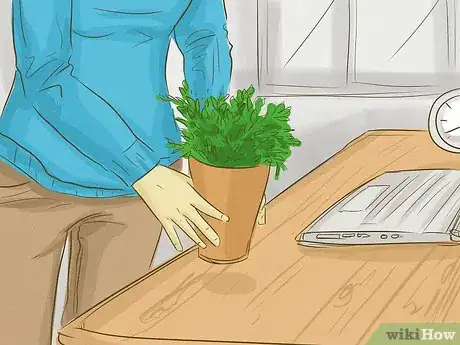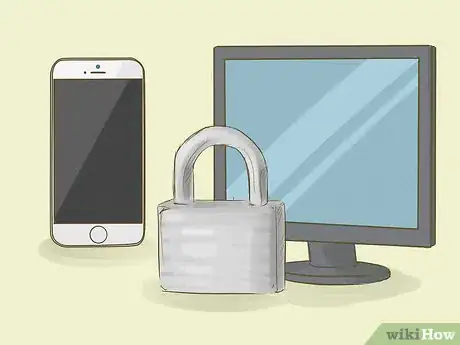This article was co-authored by Natalia S. David, PsyD. Dr. David is an Assistant Professor in Psychology at the University of Texas Southwestern Medical Center and a Psychiatry Consultant at Clements University Hospital and at Zale Lipshy University Hospital. She is a member of the Board of Behavioral Sleep Medicine, the Academy for Integrative Pain Management, and the American Psychological Association’s Division of Health Psychology. In 2017, she received the Baylor Scott & White Research Institute’s Podium Presentation Award and scholarship. She received her PsyD from Alliant International University in 2017 with an emphasis in Health Psychology.
There are 9 references cited in this article, which can be found at the bottom of the page.
wikiHow marks an article as reader-approved once it receives enough positive feedback. In this case, 91% of readers who voted found the article helpful, earning it our reader-approved status.
This article has been viewed 396,792 times.
When we have something, we tend to fear losing it. Some of our attachments can be good for us, like love and appreciation for our families, and can motivate us to be our best. But, if we are not careful, some of our attachments can control our lives, altering the way we think and act. Practicing non-attachment, or the idea of not allowing our emotions to rule our lives and decisions, helps us to think clearly and make good choices. You can do this by focusing on yourself, accepting change, and forming healthy relationships.
Steps
Practicing Meditation and Other Calming Habits
-
1Understand what non-attachment means. Those who practice non-attachment accept that jobs, relationships, and material possessions as ultimately fleeting. They fully enjoy these gifts of life in the moment instead of wishing they would last forever. When it becomes clear that something has to end, they let it go without regret. When you accept that everything must pass, you’ll allow yourself to fully experience your life, riding the movement of your emotions without being held back by them.[1]
- For example, you might have a job that you’re terrified of losing, causing you to cling tightly to it and be too nervous to do successful work. Perhaps you’re scared of losing a significant other, so you hold them too close or are afraid to show them who you really are.
- Instead, accept that there are aspects to your job or relationship that you will never be able to control. Do the best you can to make the experience worthwhile.[2]
-
2Meditate daily. Meditation asks you to focus solely on the present moment, letting go of worries about the past or future. These thoughts are attachments that are drawing you away from your center. To work at releasing them, find some time each day to be alone in a quiet space. Try to meditate for at least ten minutes initially, but extend this time daily. Focus on your breathing and your body and avoid outside thoughts.[3]
- Download meditation apps like Headspace or Calm to assist you if you are a beginner.
Advertisement -
3Let go of expectations. A fundamental aspect of non-attachment is freedom from expectations. It is often our expectations that cause us to be disappointed in others. When someone breaks plans or trust with you, don’t focus on it. Focus only on what you can do. Let go of the control they had on your happiness.[4]
- For instance, if your friend is late picking you up for a party, don’t sweat it. Call them and tell them you’ll drive yourself or find something else to do while you wait.
-
4Stay calm no matter the situation. Another principle of non-attachment is emotional and mental control. When circumstances start to upset you, this is a sign that you’re clinging too tightly to an expectation, idea, person, or thing. Take a moment to focus on your breathing. Step away from the situation to calm down so that you don’t react out of anger or sadness. Return when you feel at peace and accepting of the situation.[5]
-
5Live an ethical life. As much as is possible, conduct yourself with integrity. Often, we feel attachments to things that we shouldn’t be doing at all. Be honest with others, keep your promises, and don’t steal or hurt others. Focus on taking care of yourself, but not at the expense of others.[6]
-
6Read books about non-attachment. Find books to read to expand your knowledge and practice of non-attachment. The more you know, the easier this process will become. Read books like “A Path with Heart” by Jack Kornfield or “Unhindered: A Mindful Path Through the Five Hindrances” by Gil Fronsdal to further your learning.[7]
Accepting Change
-
1Admit that you don’t know. Part of being non-attached means recognizing that you don’t have all the answers. Perhaps you have just gone through a bad breakup. When someone asks if you’re over it, you might pretend to be or even have plans to see someone new. But, both habits are unhealthy. It’s okay to admit that you don’t know what you’ll do about a situation moving forward.[8]
-
2Stay active even when things are changing. Perhaps you are dealing with the move of a friend who you were very close with. Though this loss will sadden you, keep busy. Try not to let changes in the lives of others put a stop to your own. Plan a full list of things to do throughout the day so you don’t feel so lonely.[9]
-
3Make a change to your surroundings. Though you can’t control others, you can control yourself. If you have recently detached yourself from something or someone, make other changes in your life. Cut your hair or reorganize furniture. Declutter your space or get a puppy. Do something to shift your focus to something new. This will help you get used to change as a part of life and even embrace it, which will make it easier for you to stop clinging to things and people.[10]
-
4Find humor in the moment. When you feel the need to cling to someone, find something funny to distract yourself. Scroll down your Twitter feed to see some funny memes or call up a friend who lifts your mood. You can even take this time to poke a little fun at yourself.[11]
Maintaining Healthy Relationships
-
1Set boundaries in your relationships. Being non-attached doesn’t mean being detached from others completely. It means that you value your relationship with yourself just as much as your value your relationships with others. Set clear boundaries with partners, family, and friends so that you can both have respect and space.[12]
- For instance, maintain healthy distance. Don’t blow your spouse’s phone up if they aren’t answering; wait to be called back.
-
2Respect their privacy. Practice non-attachment by maintaining mutual privacy. Don’t feel the need to ask for or give the passwords to your phone, email, or social media. Keep some things to yourself unless they need to be shared.[13]
-
3Spend time without them. Don’t feel the need to call or text them all day; live your life! Hang out with friends without them, sometimes. Don’t feel the need to be with your partner or friends every day.[14]
-
4Address issues that arise. Should an issue arise between you and someone you are feeling attached to, address it. Find a non-busy time for the two of you to talk to hash it out. Be respectful and honest. Listen to their points and try to understand their perspective.[15]
- If you don’t address an issue, it can fester inside you and cause you to be clingy.
-
5Compromise when you don’t agree. Avoid trying to make others see and do things your way all the time. Let go of your need to control them or their actions. Instead, find areas of compromise so that you can both get some things that you want.[16]
- For instance, you might want more time with a partner but they might want more space. Agree on a certain number of nights per week to see each other.
-
6Let them go if they want to leave. You can’t and shouldn’t have to make someone stay with you. Even if you feel super close to someone, they might decide one day that they want something different. Though it’s hard, it’s going to be okay. Never beg someone to be with you; state your feelings calmly and let them go.
- If someone wants to break up, say “I don’t want to breakup, but I understand where you are coming from. I’m sad that the relationship is ending, but I wish you the best.”
-
7Keep a journal of your thoughts. Each night before bed, take a few minutes to write about your day. Write about any difficulties or successes you had or moments you felt clingy. Choosing to focus on how your day went will help you take your focus off of others.[17]
References
- ↑ https://www.elephantjournal.com/2015/09/why-non-attachment-is-one-of-the-keys-to-a-happy-life-relationship/
- ↑ https://tinybuddha.com/blog/how-non-attachment-can-benefit-your-relationship/
- ↑ https://zenhabits.net/attachments/
- ↑ https://buddhaimonia.com/blog/let-go-find-peace
- ↑ https://www.thoughtco.com/the-practice-of-buddhism-449753
- ↑ https://www.thoughtco.com/the-practice-of-buddhism-449753
- ↑ http://www.insightmeditationcenter.org/books-articles/recommended-books/
- ↑ https://www.mindbodygreen.com/articles/how-to-gracefully-accept-change
- ↑ https://www.mindbodygreen.com/articles/how-to-gracefully-accept-change
- ↑ https://www.mindbodygreen.com/articles/how-to-gracefully-accept-change
- ↑ https://zenhabits.net/12-practical-steps-for-learning-to-go-with-the-flow/
- ↑ http://www.loveisrespect.org/healthy-relationships/
- ↑ http://www.loveisrespect.org/healthy-relationships/
- ↑ http://www.loveisrespect.org/healthy-relationships/
- ↑ http://www.loveisrespect.org/healthy-relationships/
- ↑ http://www.loveisrespect.org/healthy-relationships/
- ↑ https://zenhabits.net/12-practical-steps-for-learning-to-go-with-the-flow/
About This Article
To practice non-attachment, set clear boundaries in your relationships with your family and friends so you have time to yourself as well as with them. Additionally, keep some important things, like the passwords to your phone or social media accounts, to yourself so you can maintain a certain degree of privacy. You should also spend time with others on a regular basis so you don't feel the need to be with your partner every day. Moreover, try to read books about non-attachment, such as "The Path with Heart" by Jack Cornfield, to learn more about it. For tips on how meditating can help you practice non-attachment, keep reading!

























-Step-10-Version-3.webp)





















































